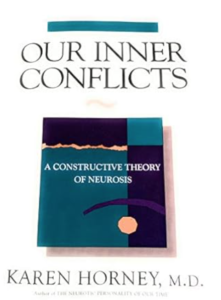Many people in our society live lives that are not fully their own. They try to become their ideal self – an image of who they SHOULD be – rather than to be who they truly are.
Although there is nothing wrong with striving to be better at something, sometimes these strivings secretly function as judgments on ourselves. We want to be better, not as a function of our natural striving for self-actualization, but to make up for our low self-esteem and a lack of ability to accept ourselves for who we are…
The student who always MUST have straight A-s on their report card may for example have an ideal self that dictates that they always be the best at what they do. If they fall short of this unrealistic standard, they may harshly criticize themselves for falling short and being a “loser”.
Underneath our high standards of self-worth, we may thus often find a harsh critical voice that condemns us as chronically deficient.
We may, in other words, be stuck in a chronic cycle of unrealistic expectations that lead to inevitable failure and periods of low self-esteem.
We may have set up what psychoanalyst Karen Horney calls a “Pride System”, where we are either chasing a self that we want to be (our ideal self), or angry with ourselves for not being who we want to be (our actual self).
The Pride System:
Pride denotes a falsely inflated virtue that has sprung up to take the place of a perceived vulnerability. I may, for example, pride myself of being all-loving and selfless in order to make up for a sensitivity I have to being accused of not being a good or morally virtuous person. At the core of my prideful pursuit of my all-loving ideal, thus lies a wound or bruise to my self-esteem that it is intended to cover or make up for.
I know that my values or virtues are really part of my pride system, rather than a sign of healthy self-esteem, if I need relentless confirmation of their veracity from the external world. For example, if I am only worthwhile if I get an A, or lovable if others praise me for my selflessness. Another sign that my pursuits are prideful is that I pursue them compulsively and inflexibly, and that my failure to be a particular kind of self produces a crisis in my self-worth and self-esteem.
What Karen Horney rightly points out is that neither the ideal self nor the self I am when I fall short of my ideals, should be confused with my true self. Both the ideal and the failure to embody one’s ideal are two side of the same failed project. In setting up my impossible ideal, I also set up my flawed self. Both go to together like night and day.
The unfortunate thing is that many people live their entire lives within their pride system and never get in touch with who they really are.
Ideals as Defenses Against Low Self-Esteem:
Most of the time, unrealistic ideals emerge early on in life as a form of protection against low self-esteem. They are frequently attempts to ward off feelings of vulnerability, anxiety, or shame.
Karen Horney talks about a “fundamental anxiety” people can experience when growing up. Fundamental anxiety is an anxiety about being who I am. It is the experience that something about me is flawed or unacceptable.
It may be, for example, that I depended on others but felt let down, or that it was unsafe to assert my needs and express anger in my family. The result of such experiences may have been that I learned to disavow my dependency needs or my healthy assertiveness, and instead decided to dedicate my life to never needing anyone or never expressing dissension.
The ideal self therefore emerges as an alternative self I can strive to be, which would be more acceptable, more admired, and will rise above the frailties and insufficiencies of my more vulnerable self.
The Ideal Selves in American Beauty:
The movie American Beauty is an excellent illustration of the extent to which we will go to flee from fundamental anxiety in an attempt to make up for low self-esteem. While very humorous, the movie is also a tragic commentary on the ways people will bend themselves to obtain praise from others, paying the price of becoming alienated from themselves in return.
Caroline:
… We meet Caroline, the self-contemptuous mother who spends her life making up for her childhood shame of being poor by adopting a workaholic lifestyle and having periodic break-downs when she falls short of meeting her ambitious goals…
Frank:
… We meet Colonel Frank Fitts, a father who spends his life pursuing military structure and discipline to ward off acknowledgement of the impulse to give in to his homosexual desires and the shame he feels about having them…
Angela:
… And we meet Angela, a flamboyant attention-seeking teenager who brags about her sexual experiences to cover up her fundamental shame of feeling boring and uninteresting…
All of these characters illustrate the price many people pay for unacknowledged low self-esteem that is relentlessly hidden underneath the pursuits of a different, better ME.
The Strategies We Use to Ward Off Low Self-Esteem:
In her excellent books on fundamental anxiety and the pride system, Our Inner Conflicts, and Neurosis and Human Growth, Karen Horney describes the various ways in which our energy and growth get diverted from our real self toward our ideal self.

In Our Inner Conflicts, she identifies several typical strategies people use to make up for their low self-esteem and secret self-contempt.
In the strategy of moving away, a person disavows any dependency needs or needs for love, to pursue an ideal of independence, self-reliance, and freedom from commitments.
In the strategy of moving towards, a person disavows any self-focus, any assertiveness of one’s needs, and any expression of dissension in order to preserve a self-mage of an all-loving, self-sacrificing, good natured human being.
In the strategy of moving against, life becomes about winning, being better than, and always being on top, but the price one pays is the inability to collaborate, to learn from others, and to be vulnerable.
Each strategy becomes pathological only in so far as it becomes rigid and unbendable. For example: I may end up in an emotionally abusive relationship with a controlling partner and not be able to stand up for myself because I have made a virtue out of always putting others first or being “self-less”, or I may become a world-traveller who idealizes my freedom from constraints, but really live a life to protect myself from my inability to be intimate and close with others.
The challenge for many people who, like the characters in American Beauty, find themselves the victims of impossible ideals, is to come to terms with the initial wounds that made them abandon themselves on the altar of their ideals.
People must realize that their ideal self is a protective device to overcome an underlying shame, anxiety, or vulnerability. They must realize they will never redeem themselves by trying to become different from their real self, but must get to the root of their underlying low self-esteem and learn to accept and embrace who they truly are.
They must embark on the process of finding compassion for themselves, so they can allow themselves to be human again, rather than aspire to live the life of a God.
About me: I am Rune Moelbak, Ph.D., a psychologist in Houston, Texas who has helped hundreds of people regain their authentic self and feel more at peace with themselves. Visit my website to learn more about my my approach to anxiety and low self-esteem.







